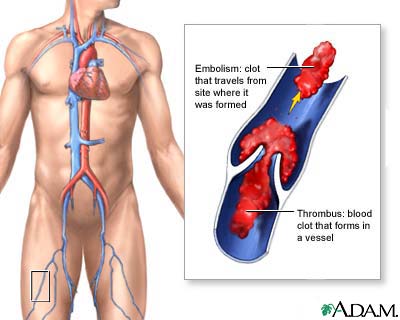Thrombolytic Therapy definition

What is Thrombolytic Therapy nad Definition
Thrombolytic Therapy is emergency treatment with medications to dissolve BLOOD clots that are in the process of forming. When initiated promptly, thrombolytic therapy can avert MYOCARDIAL INFARCTION or ischemic (nonhemorrhagic) STROKE, mitigating damage to the HEART or BRAIN respectively. Doctors also may use thrombolytic therapy to treat blood clots that form elsewhere in the body, such as in the leg (DEEP VEIN THROMBOSIS [DVT]) or the LUNGS (PULMONARY EMBOLISM).
Thrombolytic agents act by converting plasminogen, an inactive protein in the blood circulation, to plasmin, an active protein that breaks down the key proteins that form blood clots (fibrinogen and fibrin). These agents can only act before the clot fully forms and hardens, which establishes a therapeutic window of about four hours from the onset of clot formation. Early diagnosis is therefore essential.
| COMMON THROMBOLYTIC AGENTS | |
|---|---|
| alteplase (aPA) | anisoylated purified streptokinase activator complex (APSAC) |
| anistreplase | streptokinase |
| tissue plasminogen activator (tPA) | urokinase |
The oldest of the thrombolytic agents is streptokinase, which doctors began using in the 1940s. Streptokinase and anistreplase derive from streptococcal BACTERIA. When administered, these agents initiate ANTIBODY production. The antibodies become active after five days and remain active for about six months. During that timeframe, doctors cannot re-administer streptokinase or anistreplase. Some people also have adverse responses to these agents, especially streptokinase. Laboratories manufacture most of the newer thrombolytic agents using recombinant technology, which nearly eliminates these immune responses.
The most significant risk of thrombolytic therapy is uncontrolled bleeding (HEMORRHAGE). For this reason, it is crucial for doctors to determine whether a stroke is ischemic (caused by a clot) or hemorrhagic (caused by bleeding) before administering a thrombolytic agent. For venous clots, such as with deep vein thrombosis, the doctor may directly inject the agent into the clot. For arterial clots, such as with myocardial infarction or stroke, the doctor injects the agent into a vein for distribution throughout the circulation. Thrombolytic agents remain active in the bloodstream for 15 to 90 minutes, depending on the agent. With prompt initiation of thrombolytic therapy, the agent dissolves the clot and the person experiences little or no adverse effects as a consequence of the thrombolytic event.
See also ANTICOAGULANT THERAPY; IMMUNE RESPONSE.